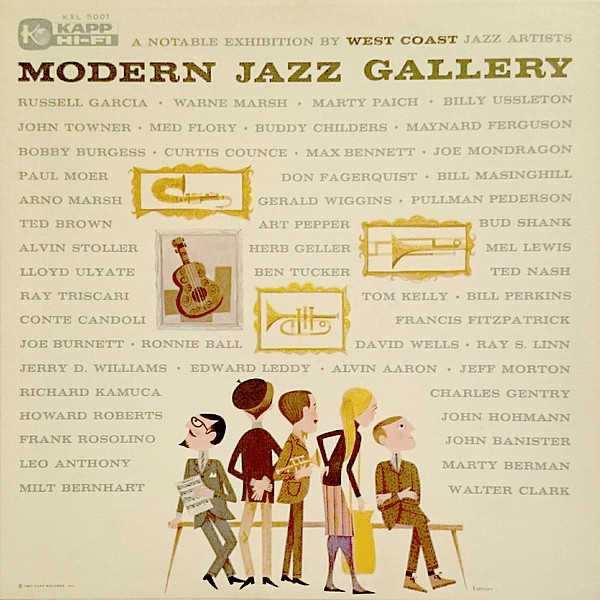Earful – Ronnie Ball
An inventive line over the changes of I'm Getting Sentimental Over You, plus a simple shout chorus. Condensed score and parts are available for the two-horn arrangement.
- Recording: Warne Marsh - Modern Jazz Gallery
- Recorded on: October 24, 1956
- Label: Kapp (KXL 5001)
- Concert Key: E-flat
- Vocal Range: , to
- Style: Swing (medium up)
- Tenor Sax - Warne Marsh, Ted Brown
- Piano - Ronnie Ball
- Bass - Ben Tucker
- Drums - Jeff Morton
Video
- Description
- Historical Notes
- Solos
- Piano Corner
- Bass Corner
- Drum Corner
- Guitar Corner
- Inside & Beyond
- Minus You
This song covers a lot of ground in terms of both range and development of melodic ideas. It's based on the standard I'm Getting Sentimental Over You. Like most songs in the tradition of the Lennie Tristano school, the melody does not repeat as the changes do; the only large-scale repeat in the melody is the recapitulation of opening theme, transposed and developed further, in the last four measures. By contrast, this melody is full of repeated, developed sequences within almost every phrase. The themes of these sequences vary in length from two beats, as at the beginning, or a beat and a half, as in the 5th measure, to a full measure in the 3rd through 7th measures of the D section in rising arpeggiated figures. These sequences exhibit a lot of rhythmic invention, right from the beginning where the first sequence begins with a 2-beat pickup. The beginning of the B section features a sequence within a sequence: a 2-beat pattern is repeated a whole step lower, and the whole 4-beat shape is transposed up a fifth starting on the second beat of the next measure. This sequence is over a reharmonization of the original I'm Getting Sentimental Over You changes, with a chord on each beat in a descending direction.
Our lead sheets and parts include the shout chorus, a simple but subtly inventive "riff" 16 measures long. On the recording it is played at the start of the last chorus, with a bass solo on the bridge, and the last 12 measures of the out melody (again shown on our lead sheets and parts) start like the B section and switch to the fifth measure of the D section, with an unexpected modulation to G major at the end. On the lead sheets and parts, the shout chorus appears on the first half of a full set of solo changes. In the 15th measure of the solo form, we put A♭m6 in parentheses on beat 3; this chord is played on the solos, but the shout chorus melody has C♮ here instead of C♭. A♭6 or A♭7 should be played at this place in the shout chorus.
On the recording, the melody starts with the two tenor saxes in unison. They harmonize in sixths in parts of the B section, and in thirds for most of the C section and the end of the D section; a few notes in the D section are harmonized to outline the changes. The shout chorus is mostly harmonized in thirds. The melody goes into the tenor sax's altissimo register; tenor saxophonists playing the melody without the 2nd part should take the altissimo passages down an octave, for example in the B section from beat 2 of the second measure through the fourth measure. Our B♭ trumpet lead sheet is written to sound in the same octave as the tenor lead sheet, except from measures 2 to 4 of the C section where it is an octave above. The C bass clef lead sheet is written an octave below the trumpet lead sheet.
Our lead sheets and parts include the shout chorus, a simple but subtly inventive "riff" 16 measures long. On the recording it is played at the start of the last chorus, with a bass solo on the bridge, and the last 12 measures of the out melody (again shown on our lead sheets and parts) start like the B section and switch to the fifth measure of the D section, with an unexpected modulation to G major at the end. On the lead sheets and parts, the shout chorus appears on the first half of a full set of solo changes. In the 15th measure of the solo form, we put A♭m6 in parentheses on beat 3; this chord is played on the solos, but the shout chorus melody has C♮ here instead of C♭. A♭6 or A♭7 should be played at this place in the shout chorus.
On the recording, the melody starts with the two tenor saxes in unison. They harmonize in sixths in parts of the B section, and in thirds for most of the C section and the end of the D section; a few notes in the D section are harmonized to outline the changes. The shout chorus is mostly harmonized in thirds. The melody goes into the tenor sax's altissimo register; tenor saxophonists playing the melody without the 2nd part should take the altissimo passages down an octave, for example in the B section from beat 2 of the second measure through the fourth measure. Our B♭ trumpet lead sheet is written to sound in the same octave as the tenor lead sheet, except from measures 2 to 4 of the C section where it is an octave above. The C bass clef lead sheet is written an octave below the trumpet lead sheet.
"Modern Jazz Gallery" is a compilation album recorded in October and November 1956, showcasing five bands active in Los Angeles at the time. It contains four songs each from Russ Garcia's and Marty Paich's big bands, and small ensembles led by Billy Usselton, John Towner Williams, and Warne Marsh. One month later, Marsh, Ball, and Ben Tucker recorded an album with alto saxophonist Art Pepper (with Gary Frommer on drums), titled "The Way It Was." A month after that was the session for "Free Wheeling," featuring the lineup heard on Marsh's "Modern Jazz Gallery" tracks plus Pepper.
Related Songs
Email Send Earful to a friend
Send this page to a friend via email. Add your name or email in the first field. In the second, add one or more email addresses, separated by a comma.

Ronnie Ball
December 22, 1927 – October 3, 1984
Ronnie Ball was born in Birmingham, United Kingdom, where he played local gigs from the age of fifteen before moving to London in 1948. There he worked with Tony Kinsey and Reggie Goff's Sextet as well as leading his own trio. He worked on the Queen Mary on the transatlantic cruise run to New York from 1949 to 1951, studying with Lennie Tristano on New York stopovers. Read more...
There was a problem.
...

